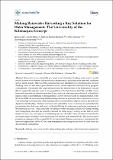| dc.description.abstract | Rainwater is conventionally perceived as an alternative drinking water source, mostly
needed to meet water demand under particular circumstances, including under semi-arid conditions
and on small islands. More recently, rainwater has been identified as a potential source of clean
drinking water in cases where groundwater sources contain high concentrations of toxic geogenic
contaminants. Specifically, this approach motivated the introduction of the Kilimanjaro Concept
(KC) to supply fluoride-free water to the population of the East African Rift Valley (EARV). Clean
harvested rainwater can either be used directly as a source of drinking water or blended with polluted
natural water to meet drinking water guidelines. Current e orts towards the implementation of the
KC in the EARV are demonstrating that harvesting rainwater is a potential universal solution to cover
ever-increasing water demands while limiting adverse environmental impacts such as groundwater
depletion and flooding. Indeed, all surface and subsurface water resources are replenished by
precipitation (dew, hail, rain, and snow), with rainfall being the main source and major component of
the hydrological cycle. Thus, rainwater harvesting systems entailing carefully harvesting, storing,
and transporting rainwater are suitable solutions for water supply as long as rain falls on earth.
Besides its direct use, rainwater can be infiltrating into the subsurface when and where it falls, thereby
increasing aquifer recharge while minimizing soil erosion and limiting floods. The present paper
presents an extension of the original KC by incorporating Chinese experience to demonstrate the
universal applicability of the KC for water management, including the provision of clean water for
decentralized communities. | en_US |

